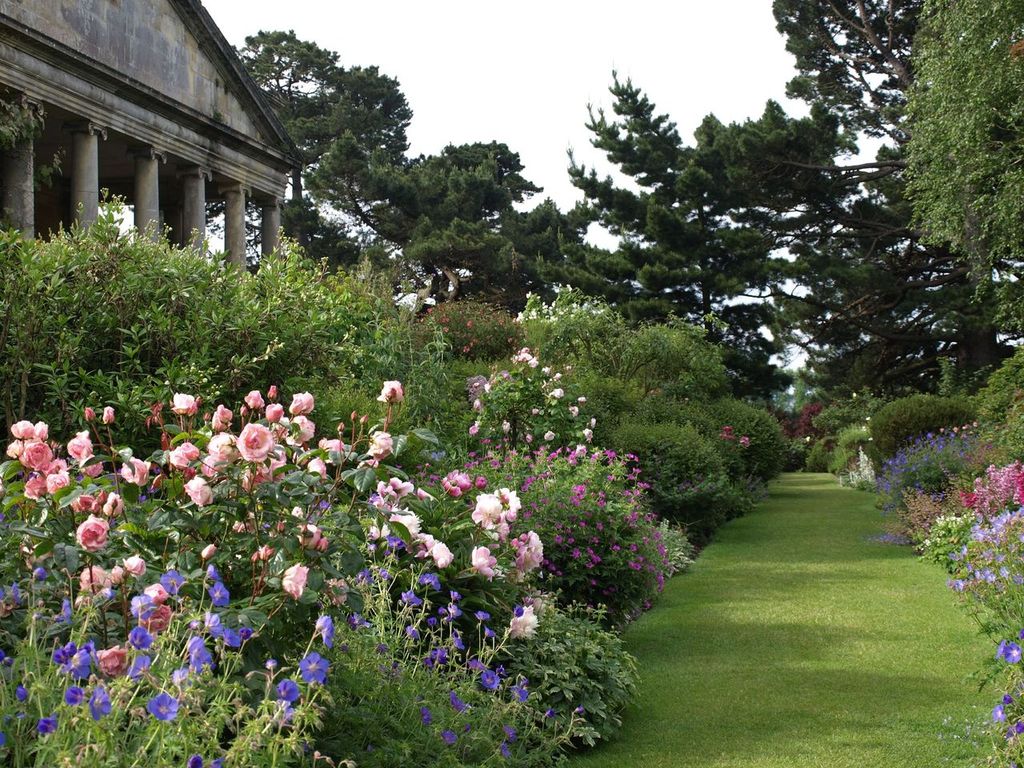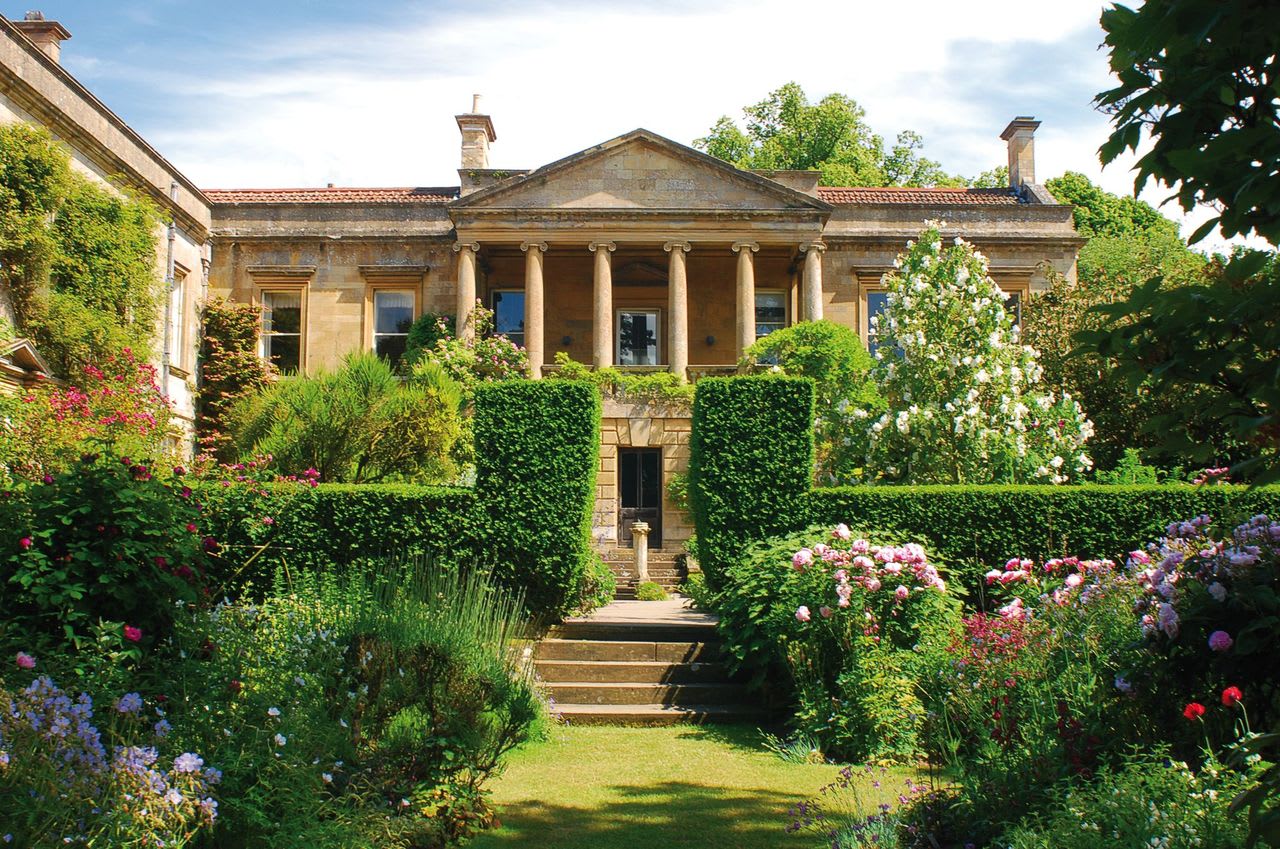The much-awaited days of summer are finally here, giving us the opportunity to get out and visit gardens we may not have previously visited – or want to return to because it gives us much pleasure. If you are looking for an exceptionally beautiful garden to explore out towards north Gloucestershire, in a village just three miles north of Chipping Campden.
The Cotswold village of Mickleton is where you will have the opportunity to discover two stunning gardens: Hidcote Manor and the less formal Kiftsgate Court, which in July will have a plethora of roses and colourful borders, all vying for your attention. You will also have the chance to see the magnificent Rosa filipes Kiftsgate, blooming as it rambles some 90 feet, smothering three trees with its profusion of white, musk scented flowers, which are hugely attractive to pollinating insects, particularly bees. July and August is a perfect time to visit; the gardens are open Sunday to Thursday from 12 noon until 6pm. Please bear in mind however, that the Kiftsgate rose is only in bloom in late June/early July so if you want to see it in all its glory, visit as soon as possible.
The house at Kiftsgate Court was built in 1887-91 by Sydney Graves Hamilton, who also owned Mickleton Manor. One of Hamilton’s ancestors had erected a Georgian front with a high portico onto the Manor and as part of his construction of Kiftsgate Court, Hamilton had the façade moved up to his new property on Glyde Hill using a special light railway. However, the back of the building is constructed as a typical Victorian country house. Nonetheless, it is not the architecture of this property that visitors go to admire, but the gardens. Kiftsgate Court gardens have been created by three generations of the same family, all woman who – until the present occupier Anne moved to Kiftsgate Court in 1988 with her husband Jonathan Chambers – had received little intervention from male partners since Mr and Mrs Muir bought the property in 1918. Even then, it was Heather Muir who created the garden.
 The views down the escarpment towards the Vale of Evesham across to the Malvern Hills are quite spectacular, too. The property is built on a hill, 183m above sea level and although it has to contend with the chill winds that sweep across the valley, the creators of the gardens have used the terraces to achieve a garden which makes you stop and take in all that you see before you, including the views.
The views down the escarpment towards the Vale of Evesham across to the Malvern Hills are quite spectacular, too. The property is built on a hill, 183m above sea level and although it has to contend with the chill winds that sweep across the valley, the creators of the gardens have used the terraces to achieve a garden which makes you stop and take in all that you see before you, including the views.
When Heather Muir moved into the property, the garden had consisted of a paved, formal area in front of the portico façade, beyond which was a plain grass field with wooded banks. Without a structured plan to work from but – inspired by her neighbour and lifelong friend, landscape-architect Lawrence Johnston who was well underway with his construction of his gardens at Hidcote Manor – Heather chose to create a garden organically. Instead of the straight lines and symmetry favoured by Johnston, she used wavy curves, allowing plants to spill over in an exuberant manner beyond the border edges. The gardens overall have a softer, more natural feel and have been created by a woman who had a natural ability to match the right plant for the right place.
Heather laid out the Four Squares Garden in front of the house; four beds planted with a collection of rare shrubs and perennials providing year-round interest. From here you can walk down the steps to the Terrace where you can admire the vista. Large terracotta pots are planted with tender plants and during the 1930s Heather tackled the steep banks to the lower garden, using plants from the Mediterranean which was a favourite place of hers. She also had a summerhouse built, once more to take advantage of the views.
 The rose for which Kiftsgate Court has become so well-known was bought by Heather Muir back in 1938 from Edward Bunyard, an esteemed botanist and nurseryman in Kent. She was led to believe that she had purchased Rosa Moschata, a white repeat flowering medium size rambler. However, in 1951 this rampant rose was identified by rosarian Graham Thomas as being Rosa filipes and it was subsequently given the cultivar name, Kiftsgate.
The rose for which Kiftsgate Court has become so well-known was bought by Heather Muir back in 1938 from Edward Bunyard, an esteemed botanist and nurseryman in Kent. She was led to believe that she had purchased Rosa Moschata, a white repeat flowering medium size rambler. However, in 1951 this rampant rose was identified by rosarian Graham Thomas as being Rosa filipes and it was subsequently given the cultivar name, Kiftsgate.
Thirty years before Rita Sackville-West created her White Garden at Sissinghurst, Heather had planted her White Sunken Garden which remains today, providing blooms from spring throughout the year. Heather also started to colour co-ordinate her planting schemes, either combining colours in a colour spectrum contrasted with grey foliage plants, or using contrasting colours, such as yellows and blue.
During WW2 and after the war, the six acres of gardens and grounds grew mostly unchecked, so when Heather’s daughter Diany Binny took over the care of her mother’s much-loved garden in 1954, she had much work to do. Working with the help of two gardeners, Diany was hands on. Over many years, she took on a number of projects, including creating a semi-circular pool and ha-ha in the Lower Garden. Here the temperatures are noticeably warmer, providing the perfect place for many tender shrubs which have now naturalised in this sheltered area. She undertook work on the Wide Border which still provides a riot of colour in shades of pinks, mauve and purple with abundant grey foliage during the summer months. Also she updated her mother’s Yellow Border which, as the season progresses, produces an abundance of annuals and late flowering perennials including the striking colours of lilies, crocosmia, dahlia, kniphofia and Heleniums bringing the late season border colour into early autumn. She further redesigned The White Sunken Garden, incorporating a small pool and a well head fountain. For the first time too, Diany opened the garden to the public.
 When Anne Chambers, Diany’s daughter, returned to Kiftsgate Court from London with her husband Jonathan and her children back in 1988, she had the chance to continue the work initiated by her grandmother and mother whilst putting her own stamp on her legacy, creating the garden as it is today. Whilst Jonathan runs the plant nursery, Anne, together with head gardener Philip Vincent and their helpers, runs the garden.
When Anne Chambers, Diany’s daughter, returned to Kiftsgate Court from London with her husband Jonathan and her children back in 1988, she had the chance to continue the work initiated by her grandmother and mother whilst putting her own stamp on her legacy, creating the garden as it is today. Whilst Jonathan runs the plant nursery, Anne, together with head gardener Philip Vincent and their helpers, runs the garden.
One of Anne’s notable achievements has been to transform what was an unkept tennis court into a new Water Garden. Created in an enclosed space, this mirror-like reflective water feature designed in black, white and green makes a striking contrast to the other parts of the garden with their palettes of colours. An impressive lotus leaf sculpture created by Simon Allison is the focal point of the Water Garden. With gilded bronze leaves floating over the water providing slight movement in the wind, water trickles off the leaves.
There is no doubt there is much to see and enjoy at Kiftsgate Court. During the summer months, the double Rose Border will be looking at its best. Filled with an assortment of old fashioned English roses, specie and modern roses, fragrance lingers in the summer air. The path running the down the middle is edged with pink striped Rosa mundi and to extend the interest throughout the year, astilbes, asters and grasses have been used to add texture and form. At the end of the path, you will see a clipped arch of whitebeam framing a statue seat created by designer Simon Verity surrounded by ferns and grasses, providing a tranquil green corner.
Still under development is the Wild Garden, which is treated as a perennial wild garden with plugs of various ‘wild’ plants being added year on year. As many of the old apple trees have died, the orchard area has been replanted with a selection of heritage apples, medlars, quince and pears. In the spring, the area features blue Camassia and dark crimson tulip Jan Reus, contrasts effectively with the apple blossom. The horseshoe shaped mound was created with the excess soil removed when the new water garden was dug, with the soil piled up on the edge of the orchard. The Avenue has been planted with tulip trees and leads to a sculpture designed and made by Pete Moorhouse.
This magnificent garden has to be visited in person to be fully appreciated. Open to the public between April to September, allow time to enjoy the garden, including refreshments in the tea-room and browse the plant stand. As the garden is on two levels, the route between the two areas can be difficult for the less mobile. For those who are unable to take on the steep decline to the lower garden, spend time on the terrace in the Four Squares garden and enjoy looking down over the lower terraces.
All images kindly supplied by Anne Chambers ©Kiftsgate Court









